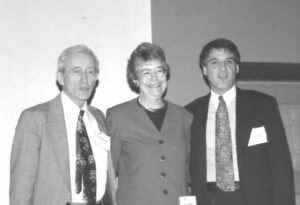It is rare to have a column about a review of an article, especially an article from almost 40 years ago but Skinner and Miller (1983) is a must-read (or re-read) article. This describes the work primarily done during Margaret (Margo) Skinner’s PhD thesis.
Margo Skinner used a master hearing aid where she was able to increase the high frequency gain and output or the low frequency gain and output, independently of each other. One of her most important findings was that in order to optimize intelligibility (and sound quality) for each increase in the high frequency region of amplification, one also required a corresponding low frequency increase as well. Just increasing the higher frequency amplification alone resulted in less-than-optimal intelligibility (and a “tinny” sound quality).
This has been known clinically for years- whenever there is a clinical modification to increase the higher frequency sound transmission, whether acoustically (e.g., Libby horn) or electronically, one needs to increase the bass response as well in order for the client to accept the sound.
However, Skinner and Miller (1983) only used speech stimuli and not music. And to be fair, only English speech stimuli. It is possible that in other languages (e.g., Japanese) where there is more dependence on lower frequency information, this high frequency/low frequency balance may not apply. The same may go for music and this is a Capstone project waiting to happen.
Many of the music programs that are currently implemented in modern hearing aid technology seek to increase the bandwidth, especially in the higher frequency region over the program(s) for speech. This is erroneous on two counts: (1) there is no data that amplified music should have a different frequency response than amplified speech, and (2) based on Skinner and Miller (1983) it is possible that a high frequency increase alone will be less than optimal unless there is a concomitant low frequency increase as well. If a hard of hearing client can tolerate an increased bandwidth in the higher frequency region, this increase should be implemented for all programs- speech and music.
Also, what is not known (and another Capstone project waiting to happen) is the opposite of the Skinner and Miller (1983) study- whether the availability of significant low frequency sound (whether amplified or merely unamplified through a vent/non-occluding ear mold system), should be balanced with a concomitant high frequency boost as well. The vast majority of current hearing aid fittings, especially in a RIC format, have some venting and many ear-tips are non- or only semi-occluding.
The research is clear for music that an extended low frequency cut-off (down to 55 Hz) of the frequency response can be beneficial for music, but this derives from well-controlled laboratory studies (e.g., Moore and Tan, 2003). Of course, this is frequently accomplished clinically with non-occluding ear-tips where unamplified low frequency sound is allowed to enter the ear canal, by-passing the hearing aid, despite the electronic specification of the hearing aid (as measured by ANSI S3.2) having a 200 or 250 Hz low frequency cut-off. And if this is allowed for music, according to the results of Skinner and Miller (1983) it is hypothesized that there should be an associated high frequency boost as well.
However, if there are cochlear dead regions that limit the high frequency end of the frequency response (such as with hearing losses greater than a moderate level (Moore and Tan, 2003) or steeply sloping hearing losses (Ricketts et al., 2008)), then caution should be exercised with using a non-occluding ear-tip/earmold coupling system that would allow an extended low frequency cut-off of the hearing aid frequency response. A narrower frequency response (on both ends) may be better than the “theoretical” wider frequency response.
Note- parts of this appeared recently in HearingReview.com. Used with permission
References:
Moore, B.C.J., and Tan, C-T. (2003). Perceived naturalness of spectrally distorted speech and music. Journal of the Acoustical Society of America, 114, 1, 408-419.
Ricketts, T.A., Dittberner, A.B., and Johnson, E.E. (2008). High frequency amplification and sound quality in listeners with normal through moderate hearing loss. Journal of Speech-Language-Hearing Research. 51, 160–172.
Skinner, M.W., and Miller, J.D. (1983) Amplification Bandwidth and Intelligibility of Speech in Quiet and Noise for Listeners with Sensorineural Hearing Loss, Audiology, 22, 3, 253-279.







